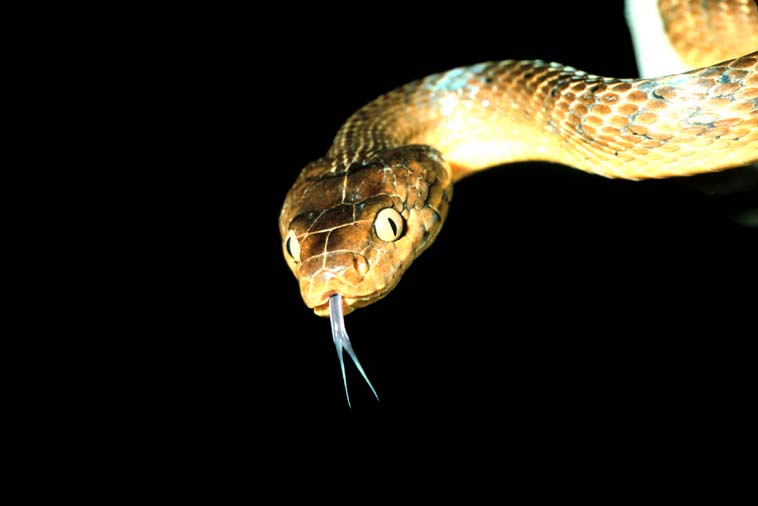- Brown tree snake
Taxobox
name = Brown tree snake
status = LC

image_width = 200px
regnum =Animal ia
phylum = Chordata
classis = Reptilia
ordo =Squamata
subordo =Serpentes
familia =Colubridae
genus = "Boiga "
species = "B. irregularis"
binomial = "Boiga irregularis"
binomial_authority = (Merrem, 1802)The Brown tree snake ("Boiga irregularis") is anarboreal colubrid snake native to eastern and northern coastalAustralia ,Papua New Guinea , and a large number of islands in northwesternMelanesia .This snake is infamous for being an
invasive species responsible for devasting the majority of the native bird population onGuam .Diet
The Brown tree snake preys upon birds, lizards, bats and small rodents in its native range. It preys on birds and
shrew s on Guam.Pianka, Eric R.; King, Dennis; King, Ruth Allen. (2004). "Varanoid Lizards of the World". Indiana University Press, 588 pages ISBN 0253343666]Due to the availability of prey and lack of predators in introduced habitats such as
Guam , they have been known to grow to larger sizes than their normal 1 to 2 meters in length. The longest recorded length of this species is one found on Guam measuring three meters.Reproduction
The reproductive characteristics of the Brown tree snake have not been widely studied. The female is known to produce 4-12 oblong eggs, 42-47 mm long and 18-22 mm wide with a leathery shell. Females may produce up to two clutches per year depending upon seasonal variations in climate and prey abundance. The female deposits the eggs in hollow logs, rock crevices, and other sites where they are likely protected from drying and high temperatures.
Venom
The Brown tree snake is a nocturnal snake that can be very aggressive when confronted. It is a rear-fanged colubrid, possessing two small, grooved fangs at the rear of the mouth.cite book |last= Mehrtens|first= John|title= Living Snakes of the World in Color|year= 1987|publisher= Sterling
location=New York |isbn= 0806964618] Due to the placement of the fangs and grooved rather than hollow fangs, the venom is difficult to convey into a bite on a human, thus is only given in small doses. The venom appears to be weaklyneurotoxic and possiblycytotoxic with localized effects, but these effects are trivial for adult humans, and serious medical consequences have been limited to children due to their low mass. This snake is still not considered dangerous to an adult human. The venom seems to be primarily used to subdue lizards, which are more easily positioned in the rear of the mouth for venom delivery.Invasive species
Shortly after
World War II , and before 1952, the Brown tree snake was accidentally transported from its native range in the South Pacific to Guam, probably as a stowaway in ship cargo.cite web | last = Fritts | first = T.H. | authorlink =
coauthors = D. Leasman-Tanner | title = The Brown Treesnake on Guam: How the arrival of one invasive species damaged the ecology, commerce, electrical systems, and human health on Guam: A comprehensive information source | work =
publisher =U.S. Department of the Interior | date = 2001 | url = http://www.fort.usgs.gov/resources/education/bts/bts_home.asp | accessdate = 11 September 2008 ] As a result of abundant prey resources on Guam and the absence of natural predators outside of feralpigs and Mangrove monitors, Brown tree snake populations reached unprecedented numbers. Snakes caused theextirpation of most of the native forest vertebrate species; thousands of power outages affecting private, commercial, and military activities; widespread loss of domestic birds and pets; and considerable emotional trauma to residents and visitors alike when snakes invaded human habitats with the potential for envenomation of small children. Since Guam is a major transportation hub in the Pacific, numerous opportunities exist for the Brown tree snakes on Guam to be introduced accidentally to other Pacific islands as passive stowaways in ship and air traffic from Guam. Numerous sightings of this species have been reported on other islands includingWake Island ,Tinian ,Rota ,Okinawa ,Diego Garcia ,Hawaii , and evenTexas in the continental United States.cite web | last = Kraus | first = Fred | title = ALIEN SPECIES | publisher = Department of Land and Natural Resources State of Hawaii | date = 2004 | url = http://www.state.hi.us/dlnr/Snake.html | accessdate = 11 September 2008 ] An incipient population is probably established onSaipan . APAP has been used to help eradicate the snake on Guam. cite web | last = Davis | first = John | title = Acetaminophen proves effective weapon against brown tree snakes | work = Kuam.com
publisher = Guam's News Network | date = 22 September 2007 | url = http://www.kuam.com/news/24582.aspx| accessdate = 11 September 2008 ]References
Wikimedia Foundation. 2010.
